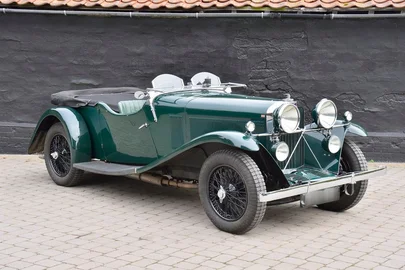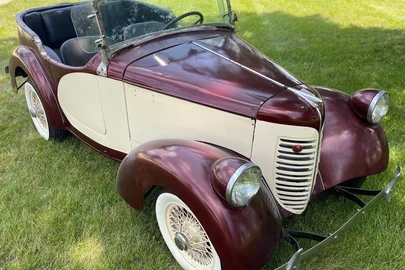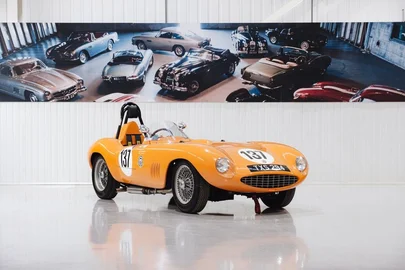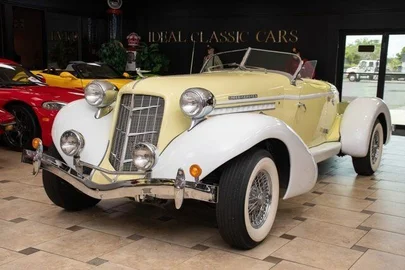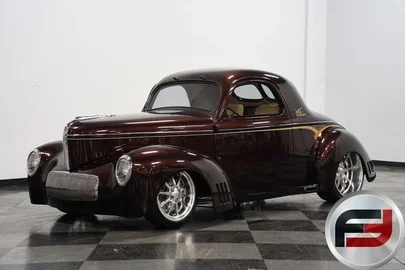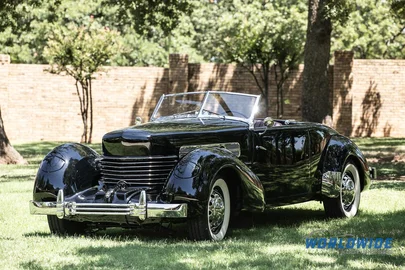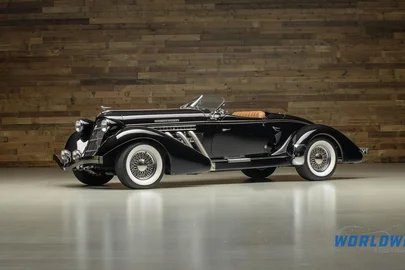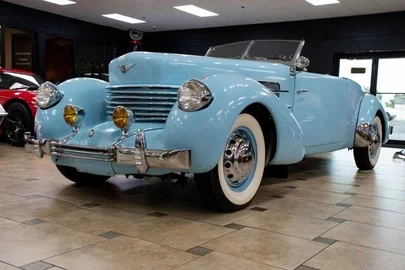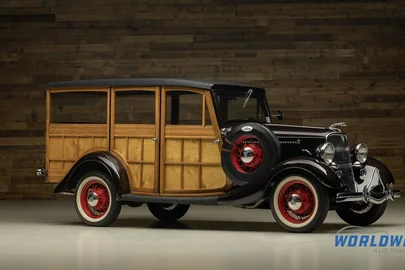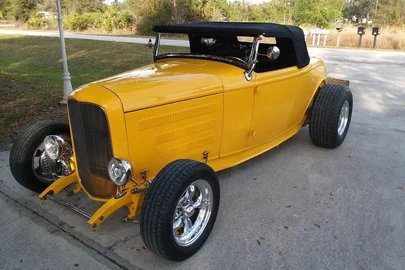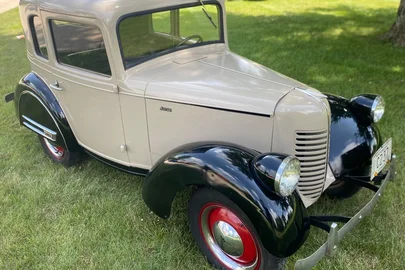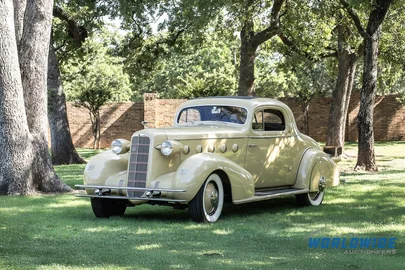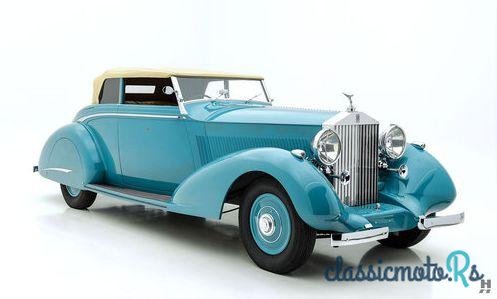
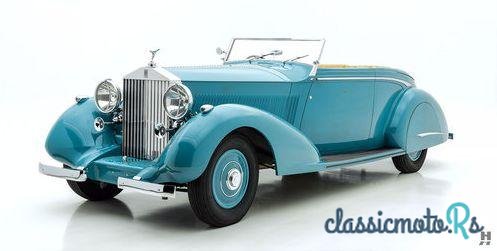
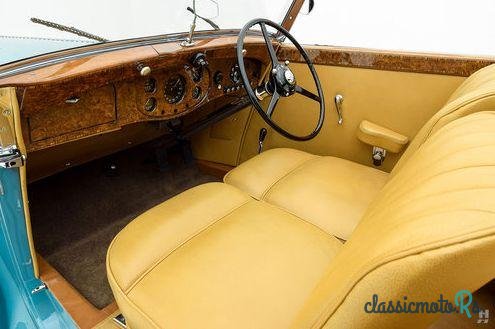
3 photos
1937' Rolls-Royce Phantom
Signaler cette annonce!Évaluer!Ajouter aux favoris
NégociablePublié 25 Août 2019ID: Be37bz
Périmée
il y a 6 années, 4 mois
il y a 6 années, 4 mois
Information from the owner
Corps: Limousine
Âge: 82 années
Couleur de la carrosserie: Bleu
Commentaires du vendeur sur 1937' Rolls-Royce Phantom
The Rolls-Royce Phantom II had proven to be one of the most successful flagship models for the marque; one that would cement Rolls-Royce’s reputation as the leader in the world luxury motorcar market. So the task of developing its replacement proved quite daunting. Despite Rolls-Royce’s status as the world’s premier automobile manufacturer, pressure from the multi-cylinder race influenced the firm’s normally conservative engineering department. The new Phantom III of 1936 would be Rolls-Royce’s entry into the multi-cylinder market, joining the likes of Pierce-Arrow, Hispano-Suiza, Marmon and Packard. Replacing the venerable inline six that traced its roots to the Ghost was an all-new, clean-sheet design V12 engine constructed of aluminum alloy and displacing 7.32 liters, or 447 cubic inches. While the V12 layout was certainly a departure for the company in terms of road car power, it was not at all unfamiliar territory given their vast experience with aero engines of the same configuration, and many of the Phantom III engine’s features borrowed heavily from the firm’s aviation experience. The Phantom III was the final car to be designed under the leadership of Sir Henry Royce, though he would not live long enough to see the car reach production.
As with the Ghost and Phantom models before it, the Phantom III was quite popular among the world’s royalty and social elite. In particular, powerful rulers from India developed a seemingly insatiable appetite for Rolls-Royce motor cars. The area that now comprises India, Pakistan and Bangladesh was once comprised of nearly 600 states, each ruled by its own prince, or maharaja. During the height of British Colonialism, the ruling maharajas enjoyed fabulous wealth and a love for the cars from Rolls-Royce, with 800 cars delivered there in the pre-war period. The marque had established itself in India in the early part of the 20th century, when in 1907, a 40/50hp “Silver Ghost” successfully traversed six treacherous mountain passes between Bombay and Kolhapur, winning a grueling reliability trial and spurring a frenzy of orders from the ruling elite. The Rolls-Royce cars delivered to India became increasingly elaborate and highly decorated, as Maharajas tried to outdo one another in an unofficial race to own the most spectacular motorcar in India. Many were ordered with special equipment for nearly an official activity or recreation imaginable, such as hunting, parades, or state business; and body styling would range from the sublime to the outrageous.
We are honored to offer one of the most beautiful of all Maharaja Rolls-Royces: The Phantom III Disappearing Roof Drophead by Thrupp & Maberly, serial number 3AZ178. This magnificent automobile was famously owned by Maharaja Bahadur Sir Kameshwar Singh, otherwise known as the Maharaja of Darbhanga. Maharaja Kemeshwar Singh was one of the wealthiest state rulers in India, amassing a huge fortune through his vast array of business interests in India and abroad. He holds the distinction of being the last titled ruler of the Raj Darbhanga state, as India gained independence in the late 1940s and he did not name an heir.
The provenance of 3AZ178 is quite fascinating. It is interesting to note that the Maharaja was not the original owner of this particular chassis. That honor goes to Joseph Coppinger of London who took delivery of the car in September of 1936, equipped then with very subdued Barker limousine coachwork. But by December of the same year, the car was returned to Rolls-Royce and sold to The Maharaja of Darbhanga, who commissioned Thrupp & Maberly to construct this staggeringly beautiful and daring coachwork, one of just two Phantom III chassis so equipped. The original limousine body was not wasted, as it was installed on another one of the Maharaja’s PIII chassis. It isn’t known exactly why Mr. Coppinger parted with his Phantom III so quickly, but it is believed that the Maharaja was open to the idea of a gently owned chassis if it drastically shortened the delivery time and allowed him to jump to the head of the waiting list. Prior to shipping it to India in 1938, The Maharaja toured Europe with the car, enjoying its effortless power and performance. When it arrived in India, it was only the second Phantom III to be dispatched to India. 3AZ178 remained a prized feature of the Maharaja’s stable through the time of his death in 1962.
Later in the 1960s, 3AZ178 was somehow wrested from the Maharaja’s family by a British National who hung about the colonies in search of interesting old cars. He exported it to England and in 1968 it was acquired by Hugh Boucher of Kent. By that time, the car still had exceptionally low miles, though cosmetically it was beginning to appear a bit tired. In the early 1990s, Boucher turned the PIII over to James Pearce Coachbuilders for a light freshening. Mr. Boucher cared for the Phantom III from 1968 through is passing in 1999, after which the car found its way to the USA. Once stateside, a prominent American collector acquired this historic Rolls-Royce in 2006, and commissioned a meticulous cosmetic restoration with highly respected classic-era expert Fran Roxas. Accompanying the car is a very large stack of receipts, correspondence and records documenting its history.
Color played an important role in the presentation of Maharajas automobiles, and this car is no exception. After painstaking research by Mr. Roxas, the original royal blue of the Raj Darbhanga was identified and carefully reproduced to repaint the car. This vivid blue accentuates the body’s breathtaking lines, and details such as the official state insignia of the Raj Darbhanga, a six pointed star with a sacred Ganges River Dolphin, adorn the doors. At the time of the restoration, the body was determined to be excellent condition, having enjoyed a pampered life both in India and in England. It exhibits an exceptionally solid feel, particularly in action of the doors. The folding roof is a marvel of engineering, with clever features such as B-pillars that disappear with the top frame, yet provide excellent weather proofing when the roof is in place.
Mechanically, the V12 engine, running gear and chassis were found to be in remarkably good condition, as it is certain the car enjoyed no-expense-spared maintenance for its entire life. It is believed that the 25,000 miles shown is genuine, and that the car has never been completely apart. The engine has been methodically serviced and presents in beautiful condition both cosmetically and mechanically. Now beautifully dialed-in, this is truly one of the finest driving Phantom IIIs we have ever encountered. It feels hewn from a solid as only true low-mileage cars do. Proper mechanical condition is critical on these highly specialized automobiles, and this Phantom III stands with the best.
The tremendous efforts of owner and restorer were rewarded at the 2012 Pebble Beach Concours d’Elegance with a 3rd in class E-2, a special group celebrating the Rolls-Royces of the Maharajas. More recently, it earned a Best in Class for Pre-war Rolls-Royce at the 2017 Amelia Island Concours d’Elegance. 3AZ178 is a stunning and highly important motorcar. The gently mellowed restoration and superb mechanical condition make it a fine choice for the collector/driver to participate in tours and road events the world over. This is a rare opportunity to acquire one of the most beautiful of all Phantom IIIs, with fascinating provenance and a world-class restoration. Surely one of the most breathtaking examples of its kind, 3AZ178 is a shining example of the grand and glorious history of Rolls-Royce in India.
Offers welcomed and trades considered
INQUIRE FOR PRICE
STOCK NUMBER 6294
For immediate assistance please call us at +1- the details below
As with the Ghost and Phantom models before it, the Phantom III was quite popular among the world’s royalty and social elite. In particular, powerful rulers from India developed a seemingly insatiable appetite for Rolls-Royce motor cars. The area that now comprises India, Pakistan and Bangladesh was once comprised of nearly 600 states, each ruled by its own prince, or maharaja. During the height of British Colonialism, the ruling maharajas enjoyed fabulous wealth and a love for the cars from Rolls-Royce, with 800 cars delivered there in the pre-war period. The marque had established itself in India in the early part of the 20th century, when in 1907, a 40/50hp “Silver Ghost” successfully traversed six treacherous mountain passes between Bombay and Kolhapur, winning a grueling reliability trial and spurring a frenzy of orders from the ruling elite. The Rolls-Royce cars delivered to India became increasingly elaborate and highly decorated, as Maharajas tried to outdo one another in an unofficial race to own the most spectacular motorcar in India. Many were ordered with special equipment for nearly an official activity or recreation imaginable, such as hunting, parades, or state business; and body styling would range from the sublime to the outrageous.
We are honored to offer one of the most beautiful of all Maharaja Rolls-Royces: The Phantom III Disappearing Roof Drophead by Thrupp & Maberly, serial number 3AZ178. This magnificent automobile was famously owned by Maharaja Bahadur Sir Kameshwar Singh, otherwise known as the Maharaja of Darbhanga. Maharaja Kemeshwar Singh was one of the wealthiest state rulers in India, amassing a huge fortune through his vast array of business interests in India and abroad. He holds the distinction of being the last titled ruler of the Raj Darbhanga state, as India gained independence in the late 1940s and he did not name an heir.
The provenance of 3AZ178 is quite fascinating. It is interesting to note that the Maharaja was not the original owner of this particular chassis. That honor goes to Joseph Coppinger of London who took delivery of the car in September of 1936, equipped then with very subdued Barker limousine coachwork. But by December of the same year, the car was returned to Rolls-Royce and sold to The Maharaja of Darbhanga, who commissioned Thrupp & Maberly to construct this staggeringly beautiful and daring coachwork, one of just two Phantom III chassis so equipped. The original limousine body was not wasted, as it was installed on another one of the Maharaja’s PIII chassis. It isn’t known exactly why Mr. Coppinger parted with his Phantom III so quickly, but it is believed that the Maharaja was open to the idea of a gently owned chassis if it drastically shortened the delivery time and allowed him to jump to the head of the waiting list. Prior to shipping it to India in 1938, The Maharaja toured Europe with the car, enjoying its effortless power and performance. When it arrived in India, it was only the second Phantom III to be dispatched to India. 3AZ178 remained a prized feature of the Maharaja’s stable through the time of his death in 1962.
Later in the 1960s, 3AZ178 was somehow wrested from the Maharaja’s family by a British National who hung about the colonies in search of interesting old cars. He exported it to England and in 1968 it was acquired by Hugh Boucher of Kent. By that time, the car still had exceptionally low miles, though cosmetically it was beginning to appear a bit tired. In the early 1990s, Boucher turned the PIII over to James Pearce Coachbuilders for a light freshening. Mr. Boucher cared for the Phantom III from 1968 through is passing in 1999, after which the car found its way to the USA. Once stateside, a prominent American collector acquired this historic Rolls-Royce in 2006, and commissioned a meticulous cosmetic restoration with highly respected classic-era expert Fran Roxas. Accompanying the car is a very large stack of receipts, correspondence and records documenting its history.
Color played an important role in the presentation of Maharajas automobiles, and this car is no exception. After painstaking research by Mr. Roxas, the original royal blue of the Raj Darbhanga was identified and carefully reproduced to repaint the car. This vivid blue accentuates the body’s breathtaking lines, and details such as the official state insignia of the Raj Darbhanga, a six pointed star with a sacred Ganges River Dolphin, adorn the doors. At the time of the restoration, the body was determined to be excellent condition, having enjoyed a pampered life both in India and in England. It exhibits an exceptionally solid feel, particularly in action of the doors. The folding roof is a marvel of engineering, with clever features such as B-pillars that disappear with the top frame, yet provide excellent weather proofing when the roof is in place.
Mechanically, the V12 engine, running gear and chassis were found to be in remarkably good condition, as it is certain the car enjoyed no-expense-spared maintenance for its entire life. It is believed that the 25,000 miles shown is genuine, and that the car has never been completely apart. The engine has been methodically serviced and presents in beautiful condition both cosmetically and mechanically. Now beautifully dialed-in, this is truly one of the finest driving Phantom IIIs we have ever encountered. It feels hewn from a solid as only true low-mileage cars do. Proper mechanical condition is critical on these highly specialized automobiles, and this Phantom III stands with the best.
The tremendous efforts of owner and restorer were rewarded at the 2012 Pebble Beach Concours d’Elegance with a 3rd in class E-2, a special group celebrating the Rolls-Royces of the Maharajas. More recently, it earned a Best in Class for Pre-war Rolls-Royce at the 2017 Amelia Island Concours d’Elegance. 3AZ178 is a stunning and highly important motorcar. The gently mellowed restoration and superb mechanical condition make it a fine choice for the collector/driver to participate in tours and road events the world over. This is a rare opportunity to acquire one of the most beautiful of all Phantom IIIs, with fascinating provenance and a world-class restoration. Surely one of the most breathtaking examples of its kind, 3AZ178 is a shining example of the grand and glorious history of Rolls-Royce in India.
Offers welcomed and trades considered
INQUIRE FOR PRICE
STOCK NUMBER 6294
For immediate assistance please call us at +1- the details below
